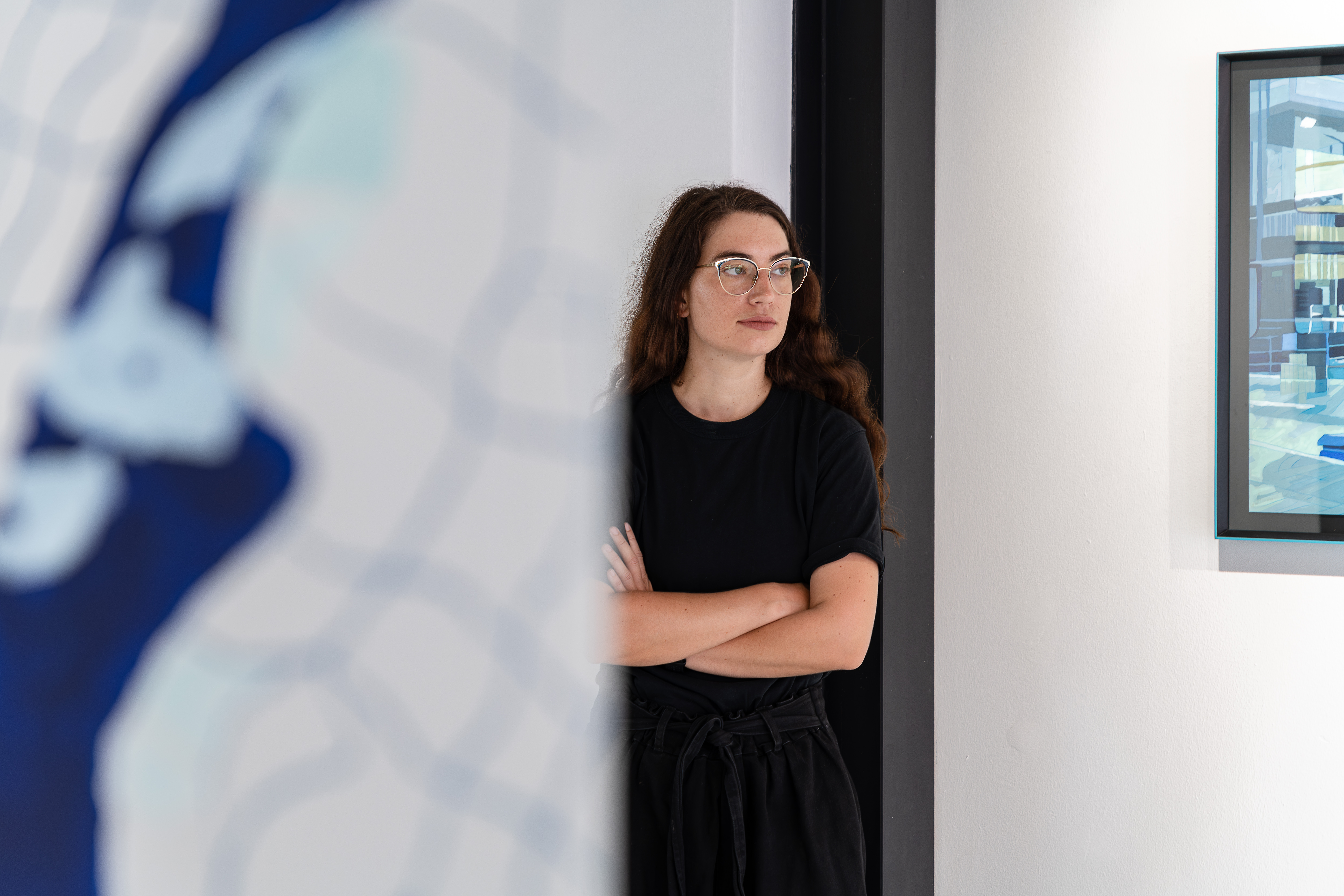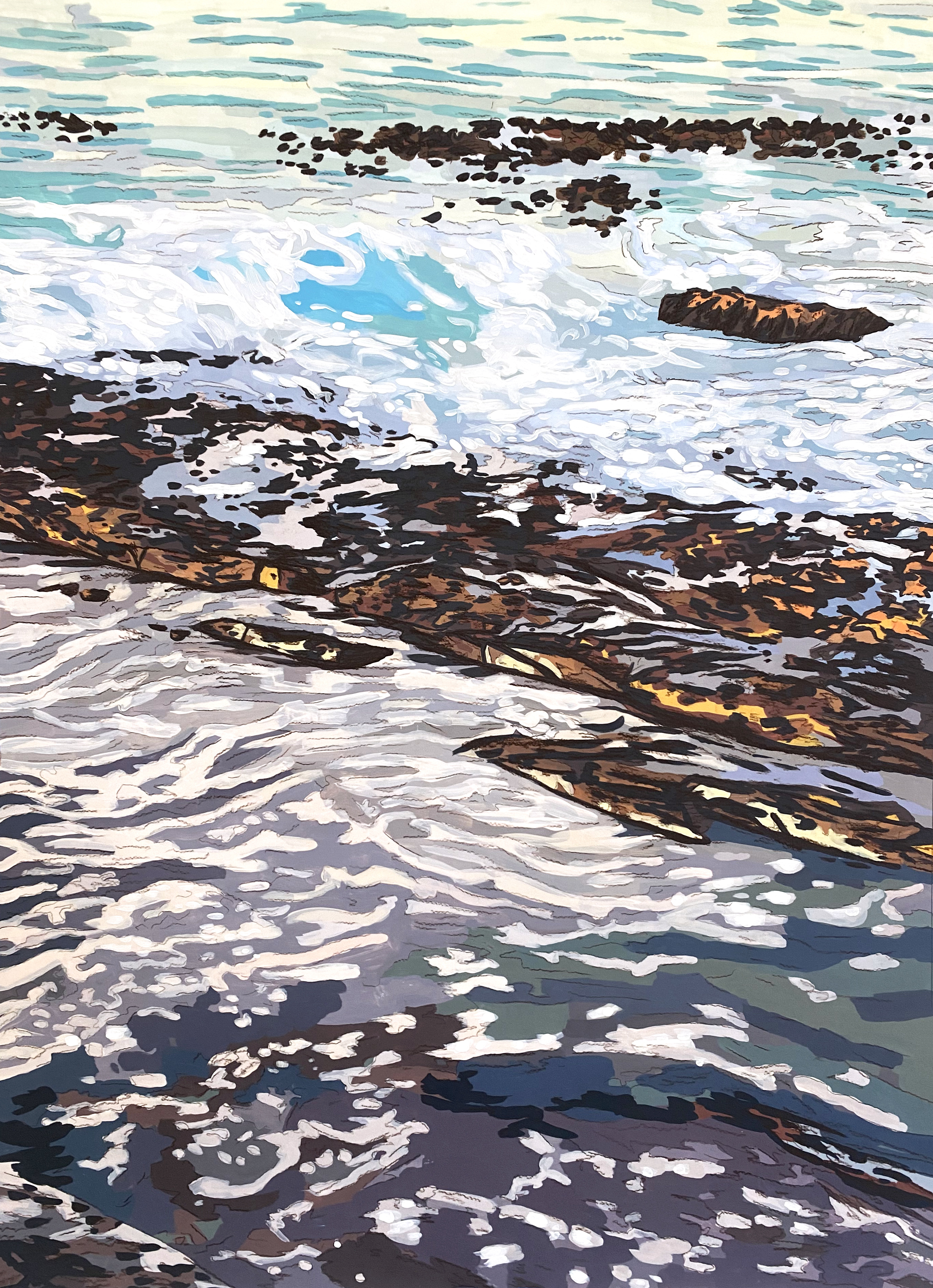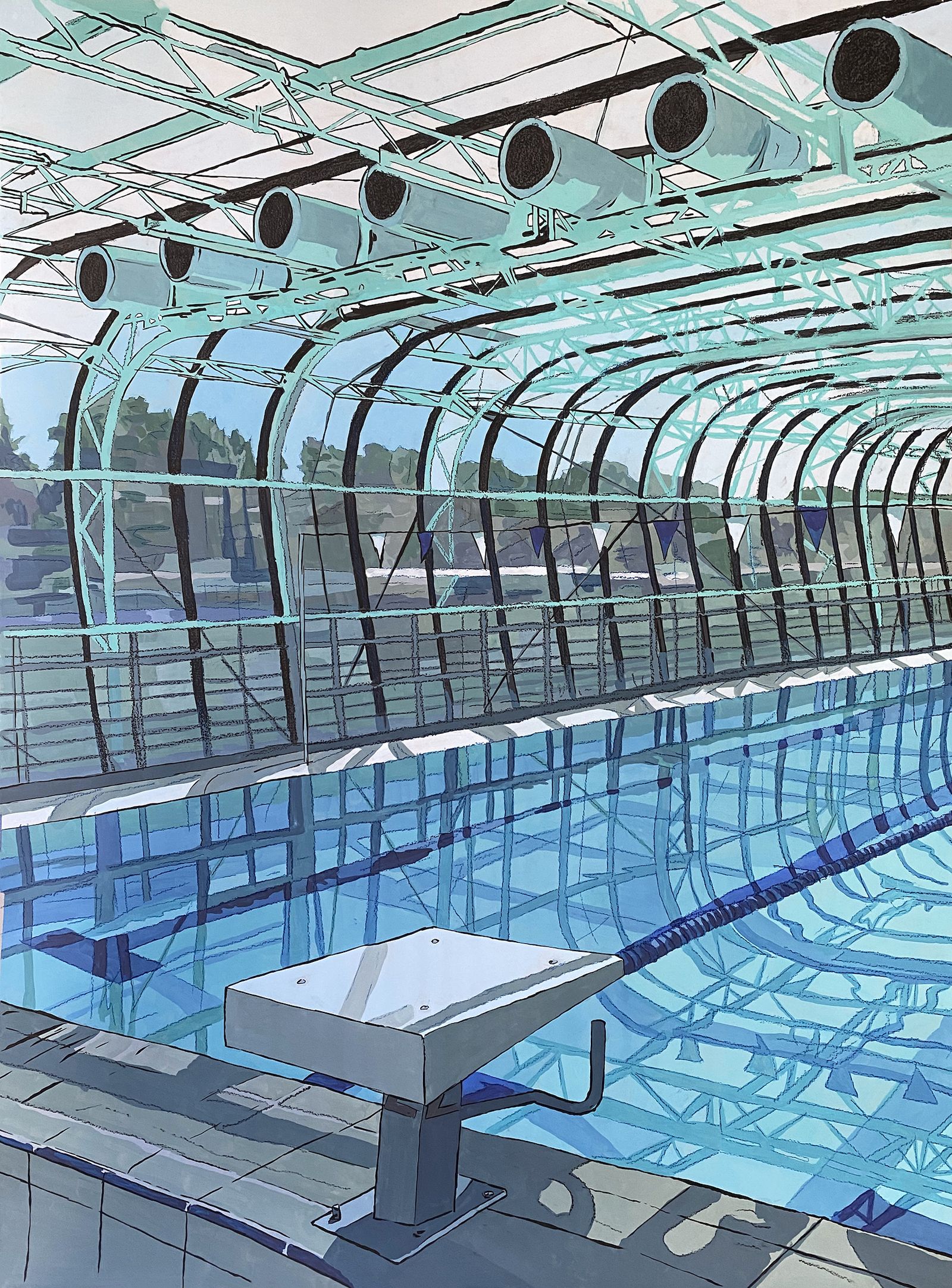Q&A with Adele van Heerden
We chatted with artist Adele van Heerden to learn more about her extensive practice.
 Adele van Heerden, Mirror exhibition, 131A Gallery, photo by Paris Brummer
Adele van Heerden, Mirror exhibition, 131A Gallery, photo by Paris Brummer
-------------
Adele van Heerden's work explores the relationships between built and natural environments, design and art, and abstraction and figuration.
Latitudes Online (LO): When did you first realise you wanted to be an artist? And how did you realise your practice from there?
Adele van Heerden (AH): I don't remember a time when I wasn't painting and drawing, it came very naturally to me from a young age. I am an only child and there was a lot of free time for just hanging out on my own with my drawing books, I took them with me everywhere I went. When the time came to start making study choices the decision to study Fine Arts felt very clear.
LO: How do you like to describe your practice? What are important thematic considerations for your practice?
AH: My work is largely autobiographical, so paintings are based on what I see and experience around me. I try to connect with the feeling of a place. When drawing and painting, I try to re-connect with those feelings; to process emotions and commemorate special moments. I try to remember and revisit them in a gentle way.
Nature has forever been a source of inspiration for me, it teaches me a lot about grounding and slowing down in a world that feels like it is chaotic and accelerating very quickly. I love how present swimming makes you feel, and I try to emulate this feeling in my artistic practice.
Thematic considerations that continue to come up in my work are the relationships between built, human-made and natural environments, design and art, and abstraction and figuration. I am continually inspired by the shorelines, architecture, and nature around my home in Cape Town.
 Adele van Heerden, Mirror exhibition, 131A Gallery, photo by Paris Brummer
Adele van Heerden, Mirror exhibition, 131A Gallery, photo by Paris Brummer
LO: I was wondering which artist[s] has/have influenced your work and how they have done so?
AH: I cannot stop talking about our lord and saviour, David Hockney!
Today he is undoubtedly one of the most influential Pop Art artists of the 20th century. I think besides his iconic work about Californian swimming pools, I resonate with him because his work and practise is sourced from love.
His subject matter is drawn from his own experiences and what he sees around him: he painted portraits of his friends and lovers, his dogs, trees, water, landscapes and reflections. His dedication to a daily drawing and painting practise is something I can relate with on a spiritual level. He's propelled by his infectious enthusiasm and interests, and moved around quite a bit. Throughout his life he lived in Paris, Bridlington, California, Malibu, Normandy, London and Bradford. This kind of multi-city living is something I fantasise about myself. He also tends to return to a particular motif, again and again, something that I seem to do myself.
LO: Talk us through the exhibition Mirror; where does the title come from, and what’s the overall theme?
AH: The exhibition is the culmination of a year-long journey that began during a residency at Cité Internationale des Arts in Paris, where I engaged in swimming in and painting the city's iconic swimming pools as part of the ongoing A La Piscine project. On returning to Cape Town, I shifted my focus to the coastal shorelines and the local municipal swimming pool, Long Street Baths. My intention was to connect with these spaces, using my body, sketchbook, and camera to observe and engage with the environment. The resulting works aim to capture the mood of these environments.
The title, "Mirror," refers to the water's surface as a physical mirror reflecting the surrounding elements, be it the sky, weather, rock, or architectural structures. This mirror, when clear, also reveals the hidden worlds beneath the water. My work has always been concerned with the connection between us humans and natural environments. The waterscapes in Mirror are all based on specific locations I have visited. As I carried on with the project it also became an interior exploration.
Water is a medium that affects light, refracting and reflecting it. One can find a whole world in a pool: sky, plants, light and darkness reflecting trees and clouds: a natural mirror. In French such a decorative tank of water one will often find in a park is called a “mirroir d'eau”. I started thinking about how to represent transparency and how one draws something one can see through. A transparent object like a piece of glass is simultaneously there and not there. It's the object itself, with ripples and sparkles on the surface, and also a medium through which you can view things. Human beings are attracted to shiny objects, things that reflect our appearance back.
This also led me to thinking about how another can act a mirror to the self. Sometimes we just need to make a connection, have our thoughts and feelings seen and reflected back to us. The metaphor of the mirror extends to the idea of individuals as mirrors to each other, reflecting personas and experiences, creating an energy transfer of seeing and being seen.
 Adele Van Heerden, Piscine Butte Aux Cailles Interior, 2023, Pastel and Gouache on Film, 84 x 118cm, R 32,200.00 ex. VAT, Presented by 131A Gallery, ENQUIRE
Adele Van Heerden, Piscine Butte Aux Cailles Interior, 2023, Pastel and Gouache on Film, 84 x 118cm, R 32,200.00 ex. VAT, Presented by 131A Gallery, ENQUIRE
LO: I’ve noticed you have an affinity to water and the colour blue – could you talk to that?
AH: The project of painting water started in 2021, when I was diagnosed with a hip condition that demanded surgery and a lot of rehabilitation, so I started swimming in the seas and pools of Cape Town. When I'm at the pool I just love to focus my eyes, and stare at the patterns from the lines and tiles at the bottom of a swimming pool. The way the water always moves and twists what is underneath, appearing like a kind of warping mesh. The "Modulations" series within the exhibition delves into these distortions and abstractions of shapes within swimming pools: the undulating lines of tiles, lanes, and the interior architecture of pools, frozen in time.
I often look out for patterns and recurrent visual motifs. During my time in Paris, I noticed a lot of a distinctive ultramarine blue hue in certain environments. The sky is the largest blue object in nature. On the other hand the ocean appears blue due to the absorption of colours in the red portion of the light spectrum. This process acts like a filter, allowing colours in the blue part of the light spectrum to remain visible to us. I think human-made swimming pools are an excellent example of merging nature and technology. The typical blue, or turquoise, or aquamarine of the pool’s painted or tiled walls gives a feeling of unreal water. Out there, in nature, bodies of water (like oceans and lakes) are often more likely to appear the colour of copper, or gunmetal, or ink, or sand.
LO: Can you talk to us about the medium and technique you use? What is gouache on film?
AH: I draw and paint onto the front and back of semi-translucent architectural drafting film, sometimes also called Mylar or Duralar, in a technique of reverse-painting I developed myself.
I'll usually start with a line drawing in pastel, colour pencil or ink. I would then turn the transparent paper around and start painting on the back of the substrate in Gouache: lightest colours first, then moving to darks and finally the mid-tones. I'll turn the paper around again, and sometimes push tonalities if I feel it's necessary. I developed this methodology over the last 4 years and I'm still finding new and interesting ways of pushing the medium.
Gouache is similar to watercolour but is modified to make it opaque. It consists of natural pigment, water and a binding agent (gum arabic or dextrin) and has been used most consistently for graphic work like posters, illustrations, comics and design work. It also has a higher ratio of pigment to binder compared to watercolours so you can get more solid colour fields compared to other water-based paints.

Adele van Heerden, Echo, 2024, Colour Pencil and Gouache on Film, 60x84cm, Presented by 131 A Gallery, ENQUIRE
LO: How does a drawing/painting emerge for you? Do you take photographs of the spaces you encounter? Or do you perhaps visit the space, sit there, sketch it and then base your painting off of that? Curious to know the journey here.
AH: Swimming is an embodied experience for me: the body serves as a sensory apparatus through which findings are made. The water-body I move in is the 'object' through which these revelations are made. I recently also started shooting underwater film photography which has been very exciting, I am returning to film photography for the first time in 15 years. The photographs turn out very differently depending on the light conditions, clarity of the water and colours in the environment. I think the human body is a convenient place from which to engage in philosophical and observational practise. In this phase I'll consider my camera and an extension of my body, eyes and brain. After this I'll print out some of my pictures, return to my studio, and create paintings based on my experiences and photographs in the form of paintings and drawings.
LO: What’s one piece of advice you can give to emerging artists trying to make their mark?
AH: Keep your friends close! In addition to continually refining and developing your practise, networking will also be your life's work. A friend once told me that networking happens when you're having fun, so concentrate on making friends you would like to have on the journey with you.
Very early on I was part of some DIY-style collectives at studios and we hosted and curated our own exhibitions throughout the years. It was very punk-rock. The first one was on top of a panel beater workshop in Harrington Street. The core-group from there is now Sidetrack Studio, and with growth and experience I think we've managed to build a supportive community - thinking back, these early years were very formative for me.
LO: How do you maintain a dedicated practice?
AH: I'm very routine-driven and I maintain a daily art-making practise. I like to set up personal rituals for myself that help the day feel more balanced and streamlined. I prefer to start early because that's when I feel clearest. I find I feel my best when I'm painting a lot. I try to work on a variety of projects throughout the year: exhibitions, commissions, residencies, collaborative projects. They all feed me in different ways.
Keeping the structure of a typical day is important, from waking up at a set time and getting dressed in all black, to going to sleep at a regular time. I have small rituals to start or end the day, whether it’s having a coffee or a quick meditation. I think having a space that is dedicated to my practice is crucial for productivity.
Once I get to the studio I try to get into a certain kind of headspace, concentration so intense that I don’t think of anything else but the painting in front of me, a state of flow. Time distorts and suddenly 5 hours has gone by and my dog is suddenly reminding me it's time to go for a walk.

Adele Van Heerden, Piscine Josephine Baker, ink and gouache on film R32,200.00 ex. VAT, Presented by 131 A Gallery, ENQUIRE
LO: During your residency in Paris, did you find the water and iconic swimming pools that you explored and researched, a similar experience to the swimming pool spaces you visit in South Africa? Or was it very different, and how so?
AH: Swimming culture is a bit different there but there are also many similarities. There are 42 municipal swimming pools in Paris. I didn't get around to going to all of them in the time I was there, but the A La Piscine project is ongoing, so I'll definitely return to continue my work and research there.
I met so many friendly people while swimming there, we managed to have conversations in the water and in the changing rooms despite my extremely limited (read, non-existent) French language skills. I think the water really opens people up, there is a mood of ebullience and connectedness with other swimmers despite our backgrounds or cultures. A lot of French people e-mailed and messaged me on Instagram when they found out about my project. Many of them wanted to go for coffee to talk more about pools, go swimming together or collaborate. Swimming in different cities made me realise that swimming relaxes people a lot, and brings strangers together in a universal kind of way.
I'm interested in the stories around pools and their specific histories. I find each pool has it's own personality and quirks. In Paris, many of them are named after important figures in French swimming history: Alfred Nakache, Suzanne Berloux, Annette Kellermann, Alice Milliat, Yvonne Godard, Jean Taris to name a few. I remember my first time getting in a Parisian pool it felt to me like there was a pool-going social contract I wasn't aware of in South Africa. I asked the person swimming next to me what the rules were. She replied: “There are many rules but we don't know what they are”.
The Long Street Baths (my local swimming pool), is an indoor “secret sanctuary” at the top of Long Street in the CBD of Cape Town. It's built in a combination of Art Nouveau, Victorian and Edwardian styles. It's an important place of gathering, part of the 'social infrastructure' that contributes to the public life of the city of Cape Town and makes it possible for people to connect and build community. In this context, the Long Street Baths is a safe space, with many good memories for people of different generations and backgrounds. I often hear about friends' fathers who used to work in the area and go swimming there at lunch time or after work, rather than going to the pub. For years the baths were known as the “slipper baths”, I read that people who lived in the flats nearby often walked over there in their slippers for a dip and shower.
The Long Street Baths is a safe place for children living on the street to have fun, when they've saved up enough money to pay the R35 entry fee. I find it a very accepting place where a great variety of different people can just “be”, whether it's the pensioner doing an easy back-stroke, newly in-love couples bobbing on a date, free-divers practising holding their breaths, or women swimming in hijabs on a Tuesday morning, which is the reserved time there for female-assigned bodies. So I think municipal pools in South Africa generally have a very relaxed atmosphere.
 Adele van Heerden, Piscine Suzanne Berloux II, 2023, Ink and Gouache on Drafting Film, 84 x 118cm
Adele van Heerden, Piscine Suzanne Berloux II, 2023, Ink and Gouache on Drafting Film, 84 x 118cm
LO: How has the residency at the Cité helped your career? And would you encourage other artists to do them?
AH: Personally, I feel residencies should be about trying new things, developing your practice, and restoring your inner well. During my residency I really tried to be present and as open as possible and really LOOK at things. Many of the lessons I learned on residency could be applied at home. Coming back to Cape Town (where I grew up and lived my entire life) I realised I could teach myself to be in this mindset at home, to look at the city with the eyes of an outsider.
I often look for patterns and recurring visual motifs when I'm on residency. A recurring visual seemed to be reflections, in all their forms. The Parisians love putting mirrors everywhere, it creates the illusion of space and light. Shop windows, refractions on top of watery surfaces like puddles after it has rained, the light from the seine refracting onto the buildings around it early in the morning and of course all the beautiful pools each with their own eccentricities.
 Adele van Heerden, Mirror exhibition, 131A Gallery, photo by Paris Brummer
Adele van Heerden, Mirror exhibition, 131A Gallery, photo by Paris Brummer
LO: Lastly, are there any exciting projects lined up for 2024 that you are able to share with us?
AH: Right now I have a few lines in the water for the next year. My intentions are to focus on making decisions that will help me to keep making art at a prolific level. I'm looking forward to further exploring reflections and fluidity, and collaborating with different creatives, artists and printmaking workshops throughout the year.I'm also planning another residency and an exhibition abroad, so I'm looking forward to moving around again for a bit.
 Adele van Heerden, Mirror exhibition, 131A Gallery, photo by Paris Brummer
Adele van Heerden, Mirror exhibition, 131A Gallery, photo by Paris Brummer
Further Reading In Articles
African Artist Directory















